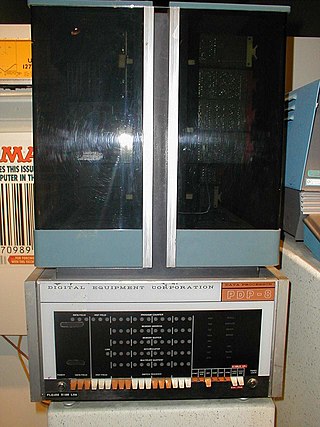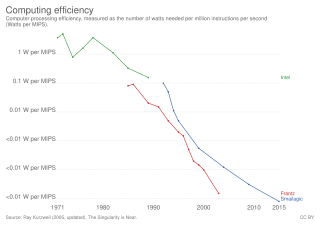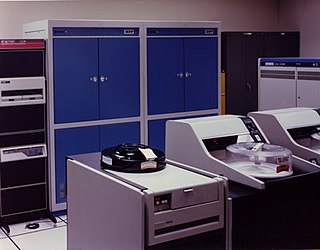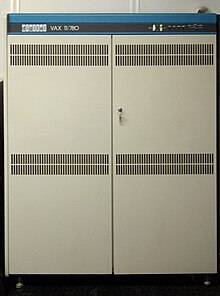
The client–server model is a distributed application structure that partitions tasks or workloads between the providers of a resource or service, called servers, and service requesters, called clients. Often clients and servers communicate over a computer network on separate hardware, but both client and server may reside in the same system. A server host runs one or more server programs, which share their resources with clients. A client usually does not share any of its resources, but it requests content or service from a server. Clients, therefore, initiate communication sessions with servers, which await incoming requests. Examples of computer applications that use the client–server model are email, network printing, and the World Wide Web.

A mainframe computer, informally called a mainframe or big iron, is a computer used primarily by large organizations for critical applications like bulk data processing for tasks such as censuses, industry and consumer statistics, enterprise resource planning, and large-scale transaction processing. A mainframe computer is large but not as large as a supercomputer and has more processing power than some other classes of computers, such as minicomputers, servers, workstations, and personal computers. Most large-scale computer-system architectures were established in the 1960s, but they continue to evolve. Mainframe computers are often used as servers.

A minicomputer, or colloquially mini, is a type of smaller general-purpose computer developed in the mid-1960s and sold at a much lower price than mainframe and mid-size computers from IBM and its direct competitors. In a 1970 survey, The New York Times suggested a consensus definition of a minicomputer as a machine costing less than US$25,000, with an input-output device such as a teleprinter and at least four thousand words of memory, that is capable of running programs in a higher level language, such as Fortran or BASIC.

Instructions per second (IPS) is a measure of a computer's processor speed. For complex instruction set computers (CISCs), different instructions take different amounts of time, so the value measured depends on the instruction mix; even for comparing processors in the same family the IPS measurement can be problematic. Many reported IPS values have represented "peak" execution rates on artificial instruction sequences with few branches and no cache contention, whereas realistic workloads typically lead to significantly lower IPS values. Memory hierarchy also greatly affects processor performance, an issue barely considered in IPS calculations. Because of these problems, synthetic benchmarks such as Dhrystone are now generally used to estimate computer performance in commonly used applications, and raw IPS has fallen into disuse.

VAX is a series of computers featuring a 32-bit instruction set architecture (ISA) and virtual memory that was developed and sold by Digital Equipment Corporation (DEC) in the late 20th century. The VAX-11/780, introduced October 25, 1977, was the first of a range of popular and influential computers implementing the VAX ISA. The VAX family was a huge success for DEC, with the last members arriving in the early 1990s. The VAX was succeeded by the DEC Alpha, which included several features from VAX machines to make porting from the VAX easier.
The 801 was an experimental central processing unit (CPU) design developed by IBM during the 1970s. It is considered to be the first modern RISC design, relying on processor registers for all computations and eliminating the many variant addressing modes found in CISC designs. Originally developed as the processor for a telephone switch, it was later used as the basis for a minicomputer and a number of products for their mainframe line. The initial design was a 24-bit processor; that was soon replaced by 32-bit implementations of the same concepts and the original 24-bit 801 was used only into the early 1980s.

Norsk Data was a minicomputer manufacturer located in Oslo, Norway. Existing from 1967 to 1998, it had its most active period from the early 1970s to the late 1980s. At the company's peak in 1987, it was the second largest company in Norway and employed over 4,500 people.

The history of computing hardware starting at 1960 is marked by the conversion from vacuum tube to solid-state devices such as transistors and then integrated circuit (IC) chips. Around 1953 to 1959, discrete transistors started being considered sufficiently reliable and economical that they made further vacuum tube computers uncompetitive. Metal–oxide–semiconductor (MOS) large-scale integration (LSI) technology subsequently led to the development of semiconductor memory in the mid-to-late 1960s and then the microprocessor in the early 1970s. This led to primary computer memory moving away from magnetic-core memory devices to solid-state static and dynamic semiconductor memory, which greatly reduced the cost, size, and power consumption of computers. These advances led to the miniaturized personal computer (PC) in the 1970s, starting with home computers and desktop computers, followed by laptops and then mobile computers over the next several decades.
Minisupercomputers constituted a short-lived class of computers that emerged in the mid-1980s, characterized by the combination of vector processing and small-scale multiprocessing. As scientific computing using vector processors became more popular, the need for lower-cost systems that might be used at the departmental level instead of the corporate level created an opportunity for new computer vendors to enter the market. As a generalization, the price targets for these smaller computers were one-tenth of the larger supercomputers.

Sixth Edition Unix, also called Version 6 Unix or just V6, was the first version of the Unix operating system to see wide release outside Bell Labs. It was released in May 1975 and, like its direct predecessor, targeted the DEC PDP-11 family of minicomputers. It was superseded by Version 7 Unix in 1978/1979, although V6 systems remained in regular operation until at least 1985.

The Model 7/32 and Model 8/32 were 32-bit minicomputers introduced by Perkin-Elmer after they acquired Interdata, Inc., in 1973. Interdata computers are primarily remembered for being the first 32-bit minicomputers under $10,000. The 8/32 was a more powerful machine than the 7/32, with the notable feature of allowing user-programmable microcode to be employed.
Bell's law of computer classes formulated by Gordon Bell in 1972 describes how types of computing systems form, evolve and may eventually die out. New classes of computers create new applications resulting in new markets and new industries.

Am2900 is a family of integrated circuits (ICs) created in 1975 by Advanced Micro Devices (AMD). They were constructed with bipolar devices, in a bit-slice topology, and were designed to be used as modular components each representing a different aspect of a computer control unit (CCU). By using the bit slicing technique, the Am2900 family was able to implement a CCU with data, addresses, and instructions to be any multiple of 4 bits by multiplying the number of ICs. One major problem with this modular technique was that it required a larger number of ICs to implement what could be done on a single CPU IC. The Am2901 chip included an arithmetic logic unit (ALU) and 16 4-bit processor register slices, and was the "core" of the series. It could count using 4 bits and implement binary operations as well as various bit-shifting operations.

The Goodyear Massively Parallel Processor (MPP) was a massively parallel processing supercomputer built by Goodyear Aerospace for the NASA Goddard Space Flight Center. It was designed to deliver enormous computational power at lower cost than other existing supercomputer architectures, by using thousands of simple processing elements, rather than one or a few highly complex CPUs. Development of the MPP began circa 1979; it was delivered in May 1983, and was in general use from 1985 until 1991.

Elxsi Corporation was a minicomputer manufacturing company established in the late 1970s in Silicon Valley, US, along with a host of competitors. The Elxsi processor was an Emitter Coupled Logic (ECL) design that featured a 50-nanosecond clock, a 25-nanosecond back panel bus, IEEE floating-point arithmetic and a 64-bit architecture. It allowed multiple processors to communicate over a common bus called the Gigabus, believed to be the first company to do so. The operating system was a message-based operating system called EMBOS. The Elxsi CPU was a microcoded design, allowing custom instructions to be coded into microcode.

Midrange computers, or midrange systems, were a class of computer systems that fell in between mainframe computers and microcomputers.

The 74181 is a 4-bit slice arithmetic logic unit (ALU), implemented as a 7400 series TTL integrated circuit. Introduced by Texas Instruments in February 1970, it was the first complete ALU on a single chip. It was used as the arithmetic/logic core in the CPUs of many historically significant minicomputers and other devices.

The K 1840, full name RVS K 1840 is a minicomputer from the German Democratic Republic (GDR). Its development began in August 1985 at VEB Robotron Elektronik in Dresden, and it went into production in 1988.

Computers can be classified, or typed, in many ways. Some common classifications of computers are given below.

















